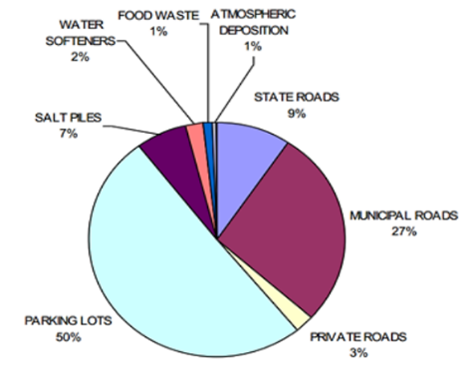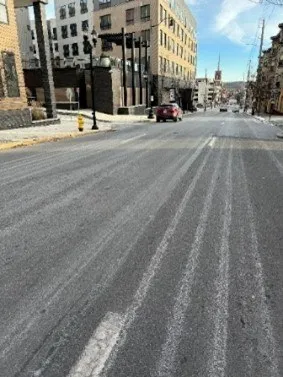Road Salt Pollution: Local and State-Wide Advocacy - Morning Ag Clips
UNIVERSITY PARK, Pa. — The graph below, from a study in New Hampshire, shows where the chloride loads from road salt pollution come from in a watershed that is similar to many in Pennsylvania. The largest source, about 50%, is from parking lots, mainly serviced by private contractors who are currently not subject to any regulation. The next biggest sector is municipal roads, with 27%. State roads contribute 9%, salt piles 7%, and the rest is from smaller sources like private roads, water softeners, food waste, and atmospheric deposition (road salt dust).
 Figure 1. Chloride loads measured in Policy – Porcupine New Hampshire watershed region (Burak, et al., 2008)
Figure 1. Chloride loads measured in Policy – Porcupine New Hampshire watershed region (Burak, et al., 2008)
Best Management Practices
Case studies performed in Minnesota and Wisconsin have demonstrated that by implementing the best management practices listed below, it is possible for municipalities and private contractors to significantly reduce road salt usage and save tens of thousands of dollars in materials and labor costs.
Training of Staff
All road maintenance staff should receive regular training about proper road salt storage, application, environmental impacts, and equipment maintenance. Any training program should emphasize the importance of using as little material as is necessary to make roads safe. This includes road salt storage, application, environmental impacts, and maintenance of equipment. Any training program should emphasize the importance of using as little material as is necessary to make roads safe.
Brining Before the Storm
Brine is a 23% solution of salt and water that can be mixed up locally. If sprayed on road surfaces ahead of a snow event, it prevents the snow from bonding to the pavement, making it easier to plow the road clean later. Road salt may still need to be applied, but the quantities will be much smaller. Switching to brining can reduce salt usage by 75%.
 Brined Street, City of Allentown (Photo: Jennifer Latzgo)
Brined Street, City of Allentown (Photo: Jennifer Latzgo)
Pre-wetting dry salt
Pre-wetting road salt with brine as it is applied enables the salt to stick better to the road surface, resulting in a 30% reduction in salt use. It also provides faster activation, making it more effective at melting snow and ice.
Calibrating Spreaders
Regular calibration of salt truck spreaders can reduce salt usage by 50%. Calibration should be done annually and any time a change is made to the material or equipment.
Use of Live-Edge Plows
Live-edge plows have a flexible, segmented edge that maximizes ground contact. They provide a cleaner scrape on uneven surfaces, meaning less salt is needed and the blades last longer. They can also allow the use of a wider plow, which means that fewer passes are needed to clear roads.
Use of Automated Spreader Controls
Automated spreader controls allow salt truck operators to program the salt application rate according to road speed. This ensures a more even spread and reduces the amount of bounce and scatter. Automated spreader controls allow salt truck operators to program the rate of salt application according to road speed. This ensures a more even spread and reduces the amount of bounce and scatter.
Covered Salt Storage
Salt piles should be covered to prevent salt loss and pollution throughout the year. Smaller piles can be covered with weighted tarps, and large piles should be kept in roofed structures with stormwater management measures in place.
Use of Road Condition Information Systems
A road condition information system is a network of road sensors, weather sensors, and other technology that collects real-time information about road conditions. They help maintenance crews strategically time road salt applications to achieve ice and snow melt with less salt.
Evaluation of Performance
After each winter maintenance event, staff should evaluate performance and analyze any data to determine effectiveness and make any necessary adjustments to future practices.
Maintenance of Equipment
Equipment needs to be rinsed off after usage to prevent corrosion. This rinsing needs to be done in a way that contains salt-contaminated wastewater, which can then be used for pre-wetting brine.
Pennsylvania Road Salt Action
Many people around the state have worked on the issue of road salt pollution locally, but so far, there has been no coordinated state-wide effort to allow the sharing of expertise and resources. So, in January 2025, the Pennsylvania Road Salt Action working group was formed to bring this about. The group includes representatives from numerous organizations and groups and has the following initial goals:
- Develop protocols and strategies for talking to municipalities and large landowners about adopting road salt best management practices.
- Create a website with materials and resources that can be used for education and advocacy.
- Encourage PennDOT to promote their training program for municipalities and emphasize road salt reduction.
- Many private contractors and the property owners who hire them are concerned about liability for slips and falls resulting from the over-application of deicers. We plan to educate decision-makers about the benefits of having a program like the Green Snow Pro program in New Hampshire, where there is limited liability for contractors who take an approved training program that emphasizes best management practices for deicer application and how to keep appropriate records.
- Work with providers to create a state-wide training program for private contractors.
- Find sources of grant money for equipment upgrades and assistance to municipalities.
 As the project moves forward, other goals may be added to this list.
As the project moves forward, other goals may be added to this list.
We are developing a network of partners along with the working group. These are organizations like watershed groups, conservation organizations, and individuals who are concerned about road salt pollution in their area and want to take action locally. They will be able to use the resources on the Working Group’s website and then share their successes and challenges so that others might benefit from their experiences.
If you or your organization is interested in being involved with this project, please complete this Google Form, and we will be in touch.
References
Cary Institute of Ecosystem Studies. (2019). Road salt: The problem, the solution, and how to get there [report].
Wisconsin Transportation Information Center. (n.d.). Wisconsin Transportation Bulletin No. 22: Pre-Wetting and Anti-Icing – Techniques for Winter Maintenance. Pre-Wetting and Anti-Icing Techniques for Winter Road Maintenance.
Witlum, M. (n.d.). 5 steps to a winter liquids program. Wisconsin Salt Wise.
Spectrum Equipment. (n.d.). How the west is adopting eastern snow removal methods.
Federal Highway Administration. (n.d.). How does the road weather information system work?. FHWA Road Weather Management – How Does the Road Weather Information System Work?
Minnesota Pollution Control Agency. (n.d.). Success stories: Salt reduction and cost saving examples success stories: Salt Reduction and cost saving examples. Success stories: salt reduction and cost saving examples – Minnesota Stormwater Manual.
Madison, A. (2021, February 12). Saltwise Municipal Champions. Municipal champions.